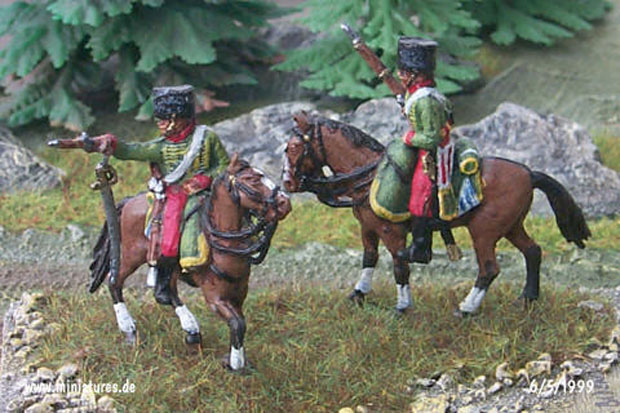Baden Hussars, 1806–1812

Upon the union of the extinct Baden-Baden lineage with Baden-Durlach in 1771, Markgrave Carl Friedrich of Baden-Durlach inherited a hussar detachment of one officer, a sergeant, fourier, and 18 hussars. The hussars served as staff aides, and mounted police patrols to uphold law and order. By the time the French Emperor Napoleon elevated Baden to a grand duchy in 1806, the Baden Hussars had been increased to a regiment of four squadrons, organized on the French model. The Baden Hussars were considered one of the best cavalry regiments in Europe; they were nominally attached to the French Imperial Guard. The 1:72 scale Revell miniatures pictured above are mounted on a 38 × 76 mm »cavalry skirmish stand« compatible with Volley & Bayonet.
Miniatures
- French Guard Chasseurs à Cheval, 1:72 Revell 02576
- Baden Hussars, 15 mm Jacobite BAN007
- Baden Hussars, Command, 15 mm Jacobite BAN008
Proprietor
- Archduke Karl Friedrich I. von Baden, 1806–1811
- Archduke Karl Ludwig Friedrich von Baden, 1811–1818
Commanding Officer
- Rittmeister von Wallbrunn, 1771
- Oberst von Freystedt, 1779
- Oberst von Laroche, 1806
Garrison
- Karlsruhe (Staff, 1st and 3rd Squadron)
- Freiburg (2nd and 4th Squadron)
Organisation
- Regimental Staff
- 1. Leib-Eskadron (4 officers, 108 hussars)
- 2. Eskadron (4 officers, 108 hussars)
- 3. Eskadron (4 officers, 108 hussars)
- 4. Eskadron (4 officers, 108 hussars)
Uniform
- green dolman with red collar and cuffs, and yellow cords
- red-yellow barrel sash
- green pelisse with black fur (white or grey for officers) and yellow cords
- officers wore a green Litewka with pointed red cuffs on campaign
- black sabretache with yellow edging and yellow »CF« monogram, or plain black sabretache on campaign
- red breeches with yellow Hungarian knots, from 1807 grey overalls with red side stripe, and from 1810 green overalls with red side stripe
- black shako with red-yellow cockade, yellow supports, yellow cords, yellow pompom and green plume, or white plume for junior officers, and white plume with scarlet base for senior officers. Officers often wore the bicorne on campaign, with a green plume for junior officers, or a green plume with scarlet base for senior officers
- elite company troopers wore black bearskin caps
- black boots with yellow trim and tassle, and silver spurs
- green boots with yellow trim, tassle, and golden spurs for senior officers
- green shabraque with yellow edging; with crown and »CF« monogram for officers
Campaign History
- Campaign against Prussian, Saxony, and Russia, 1806–1807
- Campaign against Austria in Voralberg and Tyrolia, 1809
- Invasion of Russia, 1812
On 28 November 1812, during the Battle of Berezina, the cavalry brigade of Baden Hussars and Hesse-Darmstadt Chevaulegers launched a valiant charge against superior Russian forces, from which only 50 troopers returned. This attack bought valuable time for the Grande Armée’s retreat across the Berezina.
Bibliography
- Cassin-Scott, Jack: Uniforms of the Napoleonic Wars in Colour 1796–1814, plate 12
- Haythornthwaite, Philip: Uniforms of 1812, plate 41
- Knötel-Sieg: Handbuch der Uniformkunde, p. 89